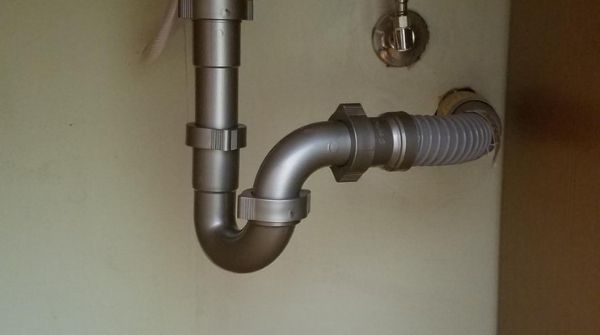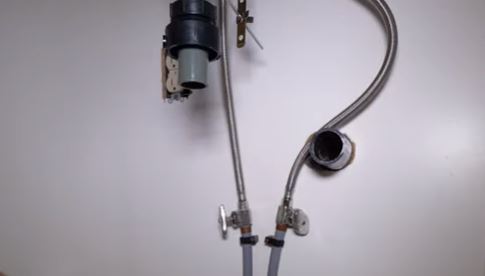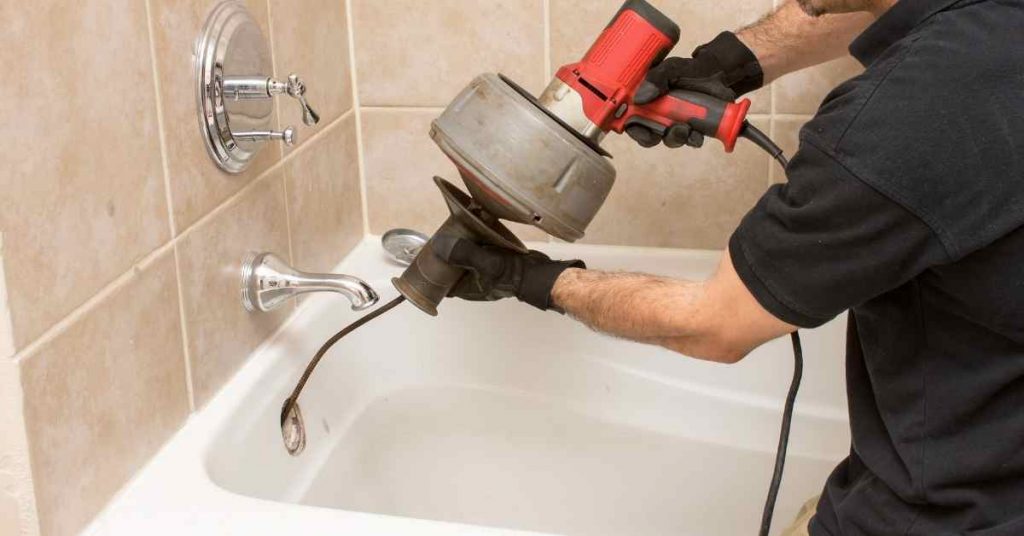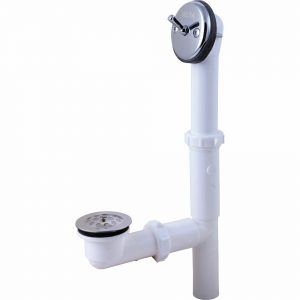
Unclogging a drain using a drain auger, also known as a plumbing snake or drain snake, is a straightforward process. Here’s a brief summary of the steps involved:
- Gather Your Tools: Ensure you have the necessary tools, including the drain auger, a bucket, rubber gloves, and eye protection.
- Prepare the Area: Clear the area around the clogged drain and put on your gloves and eye protection to prevent any splashes or mess.
- Insert the Auger: Extend the auger cable by turning the handle clockwise. Insert the cable into the drain opening until you feel resistance. This is likely where the clog is located.
- Rotate and Push: While holding the cable firmly, rotate the handle clockwise to feed the cable into the drain. Continue pushing the cable further into the pipe.
- Break Up the Clog: When you encounter resistance, the auger’s tip has likely reached the clog. Rotate the auger handle vigorously and push forward to break up the clog. You may need to apply some force but be careful not to damage the pipes.
- Retract the Cable: Slowly retract the cable by turning the handle counterclockwise. This should pull the broken-up clog and debris out of the drain.
- Clean and Repeat: Clean any debris that comes out of the drain and repeat the process if necessary. You may need to make multiple passes with the auger to completely clear the clog.
- Flush with Water: Once the drain is clear, flush it with hot water to remove any remaining debris and ensure the water flows freely.
- Cleanup: Dispose of any debris properly, clean the auger, and wash your hands thoroughly.
- Preventive Maintenance: To prevent future clogs, consider using drain screens, avoiding dumping grease or large food particles down the drain, and regularly maintaining your plumbing.
Drain snakes can either be motorized or manual. Some manual drain augers allow you to attach a drill, making it easy to turn the cable and head inside the drain.

How to Unclog a Kitchen/Bathroom Sink Drain Using a Plumber’s Snake
Kitchen and bathroom sink drains are almost identical. While kitchen drains are usually clogged by fats, oils and grease, bathroom sinks drains are normally clogged by hair, soap and shampoo combined together.
If you know how a sink drain is designed or how it works, you may not even need to use drain snake to unclog it. I will show you how to unclog a sink drain very fast.
If you look under your kitchen or bathroom sink, you will notice that part of the drain is bent into a U-shape. The U-shaped part of the drain is called a P-trap.

Every drain in your house has a P-trap only that you cannot see the one in the shower, tub or washing machine drain. You can however see the one in the toilets, which is what allows you to have water at the bottom of the bowl.
P-trap serves 2 functions. They act as a barrier preventing sewer gases from coming up the drain and also traps potential drain clogs preventing them from clogging the drain farther away where removing would be more difficult.
Most of the time when you have a clogged drain, the blockage is usually in the P-trap.
When snaking kitchen and bathroom sinks, most people opt to feed the auger through the drain opening. I don’t do that.
Feeding the cable through the sink drain opening means that the cable has to go down then up inside the P-trap, reducing its efficiency. What I like to do is to remove the P-trap and push the auger direct into the drainpipe.
That way I am able to apply maximum pressure on the clog, increasing the likelihood of breaking it down or pulling it out. Removing a P-trap also takes a minute instead of having to remove the sink strainer or pop-up stopper.
Another advantage in using this method is that you may even find the clog inside the P-trap, meaning you will not need to use the drain snake at all. Isn’t that awesome?
Here is how to snake a kitchen/bathroom sink using a drain auger:
- Start by removing all the stuff you have stored under the sink. If you use the sink cabinets to store items remove them to give yourself ample space to work with.
- Place a small bucket/pan under the P-trap. Remember the P-trap is always full of water and you do not want to spill it on the floor.
Note: If the sink is full of standing water, drain it out first before disconnecting the P-trap.
- Disconnect the P-trap. A P-trap has a short and long arm. Start by disconnecting the short arm to allow all the way in the pipe to flow out via gravity. Always attempting to loosen the P-trap connections with your bare hands before reaching out for a wrench.
- Inspect the inside of the P-trap. Is it full of gunk? If so clean, it thoroughly. If you have a double-bowl kitchen sink, remove and clean the tee (pipe connecting the 2 sink bowl drains) as well.
- Remove the P-trap arm. This is the elbow that connects the P-trap to the drainpipe on the wall.

- Carefully and slowly push the drain snake’s head inside the drainpipe.
- Release more cable from the drum and start feeding it inside the drainpipe until you encounter some resistance. This means the auger head is pushing on the clog.
- Lock the cable on the drum and start cranking the handle not to fast but also not to slowly. You can attach a drill if your snake has that option.
- Make sure the cable drum is as close to the drainpipe as possible to eliminate slack as much as you can.
- The cable should rotate but not twist/kink. If it starts twisting, crank the handle in the opposite direction and pull it out to inspect it.
- Push the cable back in again and crank the handle until you go past the restriction. Release more cable until you are sure that there are no more clogs.
- Hold a piece of rag/towel tightly around the cable as pull it out to wipe off any gunk that might have stuck on it.
- Connect back the P-trap and its arm.
- Turn on the faucet to check if the sink is draining as fast as it should.
And that is how to use a drain auger to unclog a kitchen or bathroom sink drain.
Unclogging Shower/Bathtub Drains

Just like the bathroom sink, the shower/bathtub drain is also clogged by hair which combines with soap, shampoo and oils to form a sticky gunk that blocks the drain.
To snake the shower/bathtub drain, you will first need to remove the bathtub drain stopper or shower drain cover.
A shower drain cover is usually attached using a screw or 2. Use a screwdriver to remove the screw and lift off the cover.

If you don’t see any screw, look for a slot on the side of the drain cover. Insert a flathead screwdriver in the slot and lift it off. Alternatively, grab the drain cover with needle-nose pliers and lift it off.
If you have a bathtub-shower combo, you should snake the drain from the overflow drain opening instead of the drain opening at the bottom of the tub.
For bathtubs whose drain stoppers are installed on the overflow drain (trip-lever bathtub stoppers), you will need to remove the stopper as well.

Here is how to unclog bathtub/shower drain using a plumber’s snake:
- Remove the overflow drain plate. The plate is attached using 2 screws.
- If you have a trip-lever tab stopper, pull the lever upwards then outwards to remove the entire assembly.
- Carefully insert the drain snake’s head inside the overflow drain and start pushing down the cable until you encounter resistance.
- Lock the cable on the drum.
- Crank the snake handle back and forth until you go past the resistance.
- Release more cable and push it farther down the drain to check if there is another blockage.
- Pull the cable back into the drum being careful not to swing the head inside the bathtub to avoid scratching it.
- Do the same if you are unclogging a shower drain and put back the shower drain cover.
- Connect back the bathtub overflow drain plate.
- If you have a trip-lever bathtub stopper, push back the whole assembly being careful to avoid entangling the 2 levers.
- Open the tub faucet to check if the tub is draining properly as it should.
How to Unclog a Toilet Using a Toilet Auger

As I had mentioned earlier, an ordinary drain auger is not what you want to use to unclog a toilet. A specially designed tool called a toilet auger is what I recommend using.
A toilet auger works the same way as a drain snake just that it is designed differently to enable you insert the auger head inside the drain and retrieve it as well without scratching the inside of the bowl.
Toilet augers have a curved bend called a bowl guard and a tube which are not found in ordinary drain augers.
Here is how to use a toilet auger:
- Pull the cable inside the tube until the auger head is at the bowl guard.
- Carefully introduce the auger inside the bowl and place the bowl guard at the bowl drain opening.
- Slowly push the cable up and down through the P-trap and into the drainpipe until you encounter resistance.
- Start cranking the handle back and forth until you go past the restriction.
Toilet augers are difficult to use since they have no mechanisms to lock the cable so you need to spread yourself out wide.
- When pull out the cable, drop the bowl guard at the bowl drain opening and start pulling it out. When the auger head is nicely positioned on the bowl guard, carefully remove the auger out of the bowl.
The tube and bowl guard makes it impossible for the cable and head to swing inside the bowl thereby avoiding scratches.
Toilet augers are only about 4 to 6 feet. If the clog is farther away than that, you will need to look for a longer snake. In that case what I would recommend is using the drain auger.
To do that, you may need to first remove the toilet. Removing and installing a toilet is not that hard. You will however need to replace the wax ring.
With the toilet out of the way, you will be in a position to feed the cable directly into the drainpipe and remove the clog fast. More information on that here.
The Alternative
- If you do not have a drain snake, there is an alternative. Dash to your closet and grab a wire coat hanger.
- Use pliers to straighten the coat hanger.
- If you do not have a coat wire you can use any other type of wire.
- Make a small hook on one side of the wire.
- Insert the hooked end of the wire inside the clogged drain and use it to fish out gunk.

This method is limited and will only pull out gunk from a P-trap. It is however quite effective.





